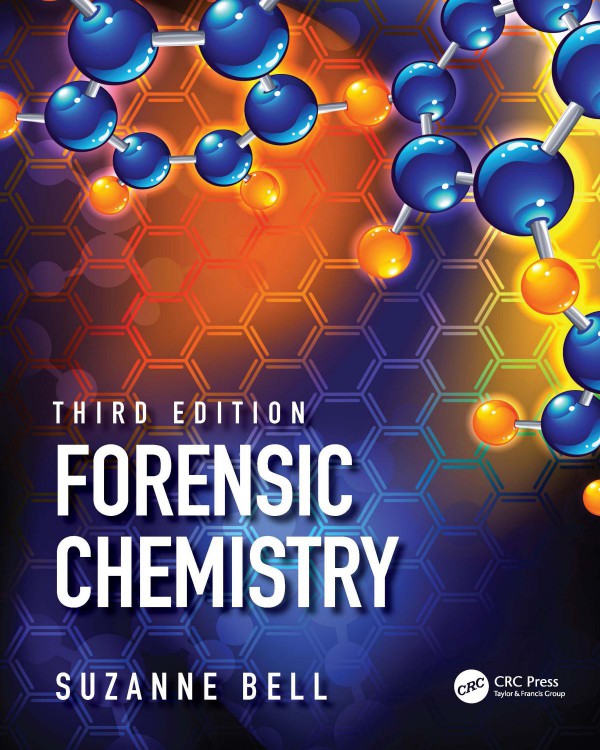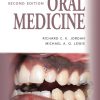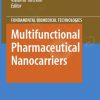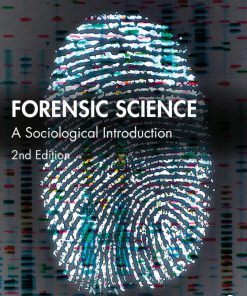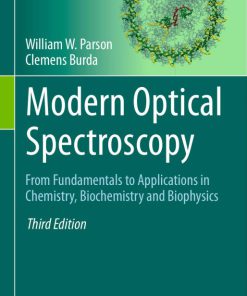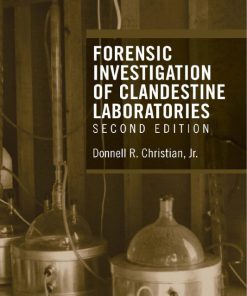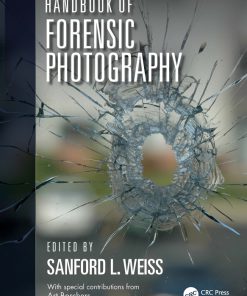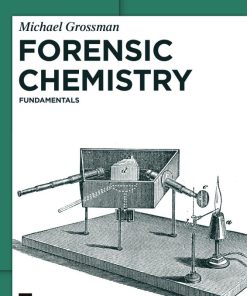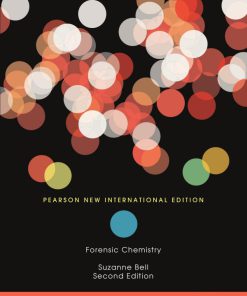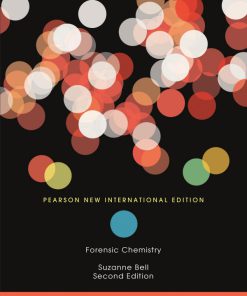(Ebook PDF) Forensic Chemistry 3rd edition by Suzanne Bell 042980444X 9780429804441 full chapters
$50.00 Original price was: $50.00.$25.00Current price is: $25.00.
Authors:Bell, Suzanne; , Series:Forensic [30] , Author sort:Bell, Suzanne; , Languages:Languages:eng , Published:Published:Mar 2022 , Publisher:CRC Press , Comments:Comments:The book provides a working foundational knowledge base for basic chemistry, introducing chemical concepts and practices from a forensic perspective.
Forensic Chemistry 3rd edition by Suzanne Bell – Ebook PDF Instant Download/DeliveryISBN: 042980444X, 9780429804441
Full download Forensic Chemistry 3rd edition after payment.
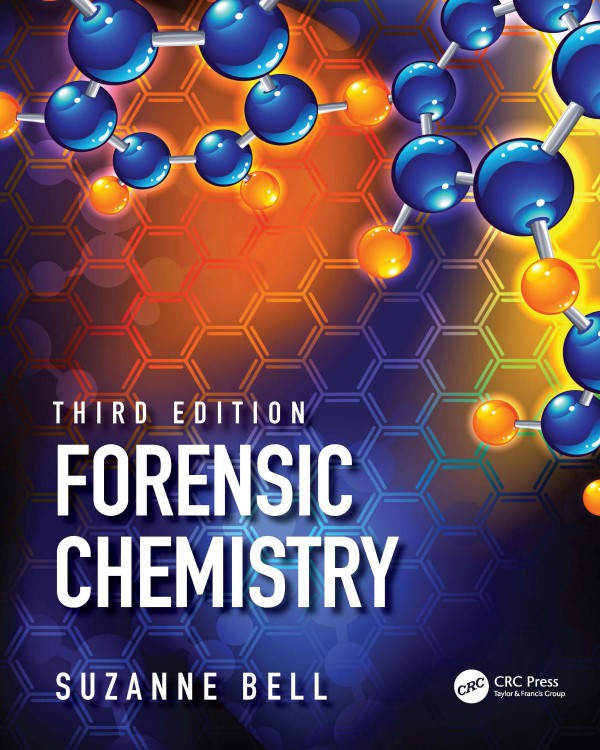
Product details:
ISBN-10 : 042980444X
ISBN-13 : 9780429804441
Author : Suzanne Bell
Forensic Chemistry, Third Edition, the new edition of this ground-breaking book, continues to serve as the leading forensic chemistry text on the market. Fully updated, this edition describes the latest advances in current forensic chemistry analysis and practice. New and expanded coverage includes rapid advances in forensic mass spectrometry, NMR, and novel psychoactive substances (NPSs). Topics related to seized drug analysis, toxicology, combustion and fire investigation, explosives, and firearms discharge residue are described and illustrated with case studies. The role of statistics, quality assurance/quality control, uncertainty, and metrology are integrated into all topics. More pharmacological and toxicokinetic calculations are presented and discussed. Hundreds of color figures, nearly 450 total, along with graphs, illustrations, worked example problems, and case descriptions are used to show how analytical chemistry is applied to forensic practice. Coverage offer students insight into the legal context in which forensic chemistry is conducted and introduces them to the sample types and sample matrices frequently encountered in forensic laboratories.
Forensic Chemistry 3rd Table of contents:
Section 1 Metrology and Measurement
1 Making Good Measurements
Chapter Overview
1.1 Good Measurements and Good Numbers
1.2 Significant Figures, Rounding, and Uncertainty
1.3 Fundamentals of Statistics
1.4 Accuracy, Precision, and Beyond
1.4.1 Types of Analytical Errors
1.5 Hypothesis Testing
1.5.1 Overview
1.5.2 Outliers and Other Statistical Significance Tests
Chapter Summary
Key Terms and Concepts
Questions and Exercises
Further Reading
Selected Open Source Resources and Articles
References
2 Assuring Good Measurements
Chapter Overview
2.1 Quality Assurance and Quality Control
2.1.1 Who Makes the Rules? International Organizations, Accreditation, and Certification
2.1.2 Traceability
2.1.3 Calibration and Control Charts
2.1.3.1 Calibration
2.1.3.2 Control Charts
2.1.3.3 Concentration and Response
2.2 Method Validation
2.2.1 Figures of Merit
2.2.2 Figures of Merit for Qualitative Methods
2.3 Sampling
2.3.1 Overview
2.3.2 Hypergeometric Sampling
2.4 Measurement Uncertainty (MU)
2.4.1 Overview
2.4.2 Identifying Contributing Factors
2.4.3 Uncertainty Budgets
2.4.4 Complex Procedures and Measurement Assurance Samples
2.5 Integration
Chapter Summary
Section Summary
Key Terms and Concepts
Questions and Exercises
Further Reading
Selected Open Source Articles and Resources
Articles
References
Section 2 Chemical Foundations
3 Chemical Fundamentals: Partitioning, Equilibria, and Acid-Base Chemistry
Chapter Overview
3.1 General Considerations
3.2 An Introductory Example
3.3 The Special K’s
3.3.1 Equilibrium Constants
3.3.2 Solubility Equilibrium Constant Ksp
3.3.3 Octanol-Water Partition Coefficient Kow (logP)
3.3.4 Partition Coefficients
3.3.5 Ka/Kb
3.4 Partitioning
3.4.1 Solvent and Liquid-Liquid Extractions
3.4.2 Water Solubility and Partitioning
3.4.3 Ionization Centers (Ionizable Centers)
3.4.4 Ionizable Centers, Drug Salts, and Solubility
3.4.5 Degrees of Ionization
3.4.6 Integrating Ionizable Centers and Solubility
3.4.7 Summary A/B, Ionizable Centers, and Solubility
3.5 Partitioning with a Solid Phase
3.5.1 Overview
3.5.2 Solid Phase Partitioning
3.5.3 Partition and Extractions
3.6 Partitioning with a Moving Phase
Chapter Summary
Key Terms and Concepts
Questions and Exercises
Further Reading
Selected Open Source Resources and Articles
References
4 Chromatography and Mass Spectrometry
Chapter Overview
4.1 Overview of Chromatography
4.2 Gas Chromatography
4.2.1 Overview
4.2.2 Instrumental Systems
4.2.3 Efficiency Measures
4.2.4 Theory
4.2.5 Retention Index
4.2.6 GC Columns
4.2.7 Gas Chromatography Detectors
4.3 Liquid Chromatography
4.3.1 HPLC and UPLC
4.3.2 Liquid Chromatography Detectors
4.4 Mass Spectrometry
4.4.1 Overview
4.4.2 GC-MS and Quadrupole Mass Filters
4.4.3 ICP-MS
4.4.4 Ambient Pressure Ionization Sources
4.4.5 Tandem Mass Spectrometry
4.4.6 High-Resolution Mass Spectrometry (HRMS)
4.4.7 DART-MS
4.4.8 Isotope Ratio Mass Spectrometry (IRMS)
4.5 Electrophoresis
Chapter Summary
Key Terms and Concepts
Questions and Exercises
Further Reading
Selected Open Source Articles and Resources
References
5 Spectroscopy
Chapter Overview
5.1 Electromagnetic Energy
5.2 Spectroscopy
5.2.1 The Basics
5.2.2 Instrument Components
5.2.3 Detectors
5.2.4 Instrument Designs
5.2.5 Bandwidth and Resolving Power
5.3 Types of Spectroscopy
5.3.1 UV/VIS Spectroscopy
5.3.2 Infrared Spectroscopy
5.3.3 Raman Spectroscopy
5.3.4 NMR Spectroscopy
5.3.5 X-Ray Spectroscopy and Scanning Electron Microscopy
Chapter Summary
Section Summary
Key Terms and Concepts
Questions and Exercises
Further Reading
Selected Open Source Resources and Articles
References
Section 3 Drugs and Poisons
6 Overview of Drug Analysis
Chapter Overview
6.1 Classification
6.2 Legislation and Regulation
6.3 Data Sources
6.4 Drugs as Physical Evidence
6.4.1 Five P’s
6.4.2 Adulterants, Cutting Agents, and Impurities
6.4.3 Clandestine Synthesis
6.4.4 Profiling
6.5 Overview of Chemical Analysis of Illicit Drugs
6.5.1 What Is Definitive Identification?
6.5.2 Chemistry of Color Tests
6.6 Current Issues: Marijuana
Chapter Summary
Key Terms and Concepts
Questions and Exercises
Further Reading
Selected Open Source Articles and Resources
Articles
References
7 Novel Psychoactive Substances
Chapter Overview
7.1 History
7.2 Legislation, Regulation, and Chemical Similarity
7.3 Categories of NPSs
7.3.1 Cannabinoids
7.3.2 Stimulants and Hallucinogens
7.3.3 Opioids
7.4 Laboratory Approach for NPSs
7.4.1 Analytical Schemes
7.4.2 Non-target Analysis
7.5 Case Examples
Summary
Key Terms and Concepts
Review Questions and Exercises
Selected Open Source Articles and Resources
References
8 Fundamentals of Toxicology
Chapter Overview
8.1 Pharmacokinetics
8.1.1 Ingestion
8.1.2 Absorption
8.1.2.1 Oral Ingestion
8.1.2.2 Bioavailability
8.1.3 Distribution
8.1.4 Metabolism and Elimination: Kinetics
8.1.5 Summary of ADME with Calculations and Applications
8.1.6 Metabolism: Biochemical Aspects
8.1.7 Tracking a Dose
8.1.8 Endogenous vs Exogenous Substances
8.2 Dosage Considerations and Lethal Concentrations
8.3 Mechanism of Action
Chapter Summary
Key Terms and Concepts
Questions and Exercises
Further Reading
Selected Open Source Articles and Resources
References
9 Applications of Forensic Toxicology
Chapter Overview
9.1 Types of Forensic Toxicology
9.2 Sample Types
9.2.1 Blood and Plasma
9.2.2 Urine
9.2.3 Vitreous Fluid
9.2.4 Tissues and Other Samples
9.2.5 Hair
9.2.6 Oral Fluid
9.2.7 Ion Trapping and Relative Concentrations
9.3 Analytical Methods
9.3.1 Immunoassay
9.3.2 MS methods
9.4 Forensic Toxicology in Practice
9.4.1 Ethanol
9.4.1.1 Alcohol Metabolism
9.4.1.2 Absorption, Distribution, and Elimination
9.4.1.3 Breath Alcohol
9.4.1.4 BAC Laboratory Analysis
9.4.2 Postmortem Toxicology
9.4.2.1 Postmortem Redistribution
9.4.2.2 Tracking Doses across Tissues and Fluids
9.5 Integrated Examples and Cases
9.5.1 Heroin
9.5.2 Bupropion
9.5.3 NPS Mixed Drug Fatality
Chapter and Section Summary
Key Terms and Concepts
Questions and Exercises
Further Reading
Selected Open Source Articles and Resources
References
Section 4 Combustion Evidence
10 Overview of Combustion Chemistry
Chapter Overview
10.1 Combustion Basics
10.1.1 Overview
10.1.2 Reaction Mechanisms and Kinetics
10.1.3 Types of Combustion
10.1.3.1 Smoldering
10.1.3.2 Flames and Ignition
10.2 Thermodynamics of Combustion Reactions
10.2.1 General Considerations
10.2.2 Stoichiometry
10.2.3 Mass and Heat Transfer
10.3 Propagation
10.3.1 Deflagration to Detonation
10.4 Fire Behavior
10.4.1 Propagation over Liquids
10.4.2 Walls and Inclined Surfaces
10.4.3 Ceiling Jets and Flashover
Chapter Summary
Key Terms and Concepts
Review Questions and Exercises
Further Reading
Selected Open Source Resources and Articles
References
11 Fire Investigation and Fire Debris Analysis
Chapter Overview
11.1 Fire Investigation
11.2 Fire Debris Analysis
11.2.1 Preconcentration Methods
11.2.2 Data Analysis and Interpretation
11.2.2.1 Chemical Pattern Evidence
11.2.2.2 Detection Limits
11.2.2.3 Matrix and Substrates
11.2.2.4 Weathering and Environmental Degradation
11.3 Forensic Investigation of Fire Deaths
11.3.1 Mechanism of Toxicity
11.3.2 Analytical Methods
11.3.3 Integration with Autopsy
Chapter Summary
Key Terms and Concepts
Review Questions and Exercises
Further Reading
Selected Open Source Articles and Resources
References
12 Explosives
Chapter Overview
12.1 Explosions and Explosive Power
12.1.1 Types of Power
12.1.2 Classification Schemes
12.2 Chemical and Thermodynamic Considerations
12.2.1 Balancing Equations
12.2.2 Oxygen Balance
12.2.3 Explosive Power and Thermodynamic Calculations
12.2.4 Balancing Summary
12.3 Explosive Devices
12.3.1 Pipe Bombs
12.3.2 Other Types of IEDs and Explosives
12.4 Forensic Analysis of Explosives
12.4.1 Stand-off Detection
12.4.1.1 Vapor Phase Detection
12.4.1.2 Spectroscopy
12.4.2 Laboratory Analysis of Explosives
12.4.2.1 Overview
12.4.2.2 Ion Chromatography
12.4.2.3 Mass Spectrometry
12.5 Integrated Example
Chapter Summary
Key Terms and Concepts
Questions and Exercises
Further Reading
References
13 Firearms and Firearms Discharge Residue
Chapter Overview
13.1 How Guns Work
13.2 Primers and Propellants
13.3 Forensic Analysis of FDR and GSR
13.3.1 Color Tests and Distance Estimations
13.3.2 GSR
13.3.3 Organic Gunshot Residue
13.3.4 Time Since Discharge
13.3.5 Implications
13.4 Serial Number Restoration
Chapter Summary
Section Summary
Key Terms and Concepts
Questions and Exercises
Further Reading
Selected Open Source Resources and Articles
References
14 Forensic Chemistry and Trace Evidence Analysis
Chapter Overview
14.1 Trace Evidence Overview
14.1.1 Chemical Pattern Evidence Revisited
14.1.2 Example Scenario
14.2 Successive Classification
14.3 Characterizing Color
14.3.1 Making Color Quantitative
14.3.2 CIE System
14.3.3 Munsell System
14.3.4 Other Systems and Conversions
14.3.5 Colorants
14.4 Example Types of Trace Evidence
14.4.1 Fibers
14.4.2 Paint
14.4.3 Glass
Chapter Summary
Key Terms and Concepts
Questions and Exercises
Further Reading
Selected Open Source Resources and Articles
References
Appendix 1: Glossary of Terms
Appendix 2: Abbreviations
Appendix 3: Tables for Statistical Testing
Appendix 4: Selected Thermodynamic Quantities
Appendix 5: Selected and Characteristic Infrared Group Frequencies
Appendix 6: Selected 1H NMR Chemical Shifts
Appendix 7: Periodic Table of the Elements
People also search for Forensic Chemistry 3rd:
what is the scope of forensic chemistry
define forensic chemistry
history of forensic chemistry
forensic 3 forensic chemistry and toxicology
introduction to forensic chemistry
You may also like…
eBook PDF
Forensic Chemistry Pearson New International 2nd Edition by Suzanne Bell 129202044X 9781292020440
eBook PDF
Forensic Chemistry Pearson New International 2nd Edition by Suzanne Bell 129202044X 9781292020440

